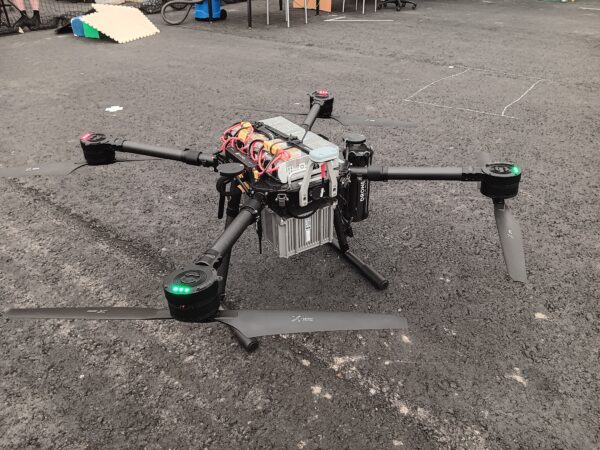On Wednesday the 22nd of May the day had finally come to test the new ArcSky X55 drone with our inertial measurement unit. Our drone operator, DroneSystems, had conducted several test flights after the drone had returned from repair and installation of a safety parachute. Now it was time to change the dummy payload with the real IMU.
The initial test flight was planned to take place on the outskirts of Copenhagen at a DTU facility, but due to heavy wind, the test flight was moved to inside our Autonomous System Test Arena (ASTA). ASTA provides an infrastructure for testing mobile robot technology on land, in air, and on/under water. For us, ASTA was an ideal alternative to be used as it allows for tracking of GNSS signals in a screened environment.
Since our last drone campaign, the IMU has received an upgrade now containing a state-of-the-art internal dual-frequency GNSS receiver. Lab tests have shown that the IMU can run on our small 4S batteries for 1,5 hours. In addition, we have built a battery setup that enables changing and charging of batteries, which ensures continuous power during field campaigns.
During our field campaigns, two different surveying techniques will be applied. The area will either be observed in a traditional way where each flight line is surveyed using constant flight speed, which together with the applied filter length determines the spatial resolution, or by an alternative method where we exploit the hover capability of the drone allowing for point-wise observations.
In the test flight last week, we wanted to test two primary objectives:
- Carry out the first test flight with the real IMU installed on the drone. See the drone’s stability and performance.
- Vibration analyses and data collection of both IMU and GNSS data.
During the flight test, we repetitively flew a small trajectory and then hovered over the same location. This simulates the survey technique of method 2. Data analysis of both GNSS and IMU data is underway to obtain some first gravity estimates.
The test indicates an effective flight time of around 20 minutes, which is a significant increase from the previous estimated 15 minutes. The total drone with full configuration weighs 24,7-8 kg, which is below the weight limitation of 25 kg.
In one of the coming weeks, we will conduct a full outdoor flight test on a nearby airfield in Copenhagen. Here we will perform a full-scale flight test simulating survey lines of the same length as what is planned for the upcoming field campaigns in Sweden and Germany.
Stay tuned!




